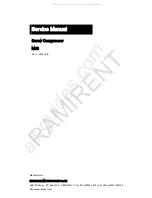
6. APPLIANCE CARE
5. TROUBLESHOOTING
MAINTENANCE
Draining The Pressure Tank
WARNING!
RELEASE ALL AIR PRESSURE FROM THE
TANK BEFORE OPENING THE DRAIN VALVE. TAKE CARE
WHEN DISCHARGING AIR THROUGH THE DRAIN VALVE
OR AIR OUTLETS. THE DISCHARGED AIR CAN CAUSE
DUST, STONES, OR ANY OTHER FOREIGN PARTICLES
TO BE BLOWN THROUGH THE AIR AT HIGH PRESSURE.
Air in the compressor tank causes water to accumulate. This must
be drained off frequently to prevent corrosion and damage to the
unit.
This should be performed after each use and prior to the
next use.
1. Turn the drain valve plug clockwise to open it.
2. Allow all of the water in the
tank to drain out.
3. Replace the drain valve plug.
Note:
The tank will not pressurise while the drain valve is open.
Symptom
Possible Cause
Suggested Solution
The compressor does
not start
Compressor has
reached cut-out
pressure
Compressor will
automatically start
once below the cut-in
pressure.
No power supply
Check the power supply,
the power plug and the
socket-outlet.
Insufficient supply
power
Reduce length of
extension lead.
Outside temperature
is too low
Never operate with an
outside temperature of
below 5°C.
Motor is overheated Allow the motor to cool
down. If necessary,
remedy the cause of the
overheating.
The compressor
starts but there is no
pressure
The seals are
damaged.
Check the seals and
have any damaged seals
replaced by a service
centre.
The drainage valve
leaks.
Ensure it is properly
closed.
The compressor
starts, pressure
is shown on the
pressure gauge, but
no pressure to the
air tool.
Loose hose
connections
Check the compressed
air hose and tools and
replace if necessary.
Leak in a quick-lock
coupling
Check the quick-lock
coupling and replace if
necessary.
Insufficient pressure
set on the pressure
regulator.
Open the pressure
regulator further.


























